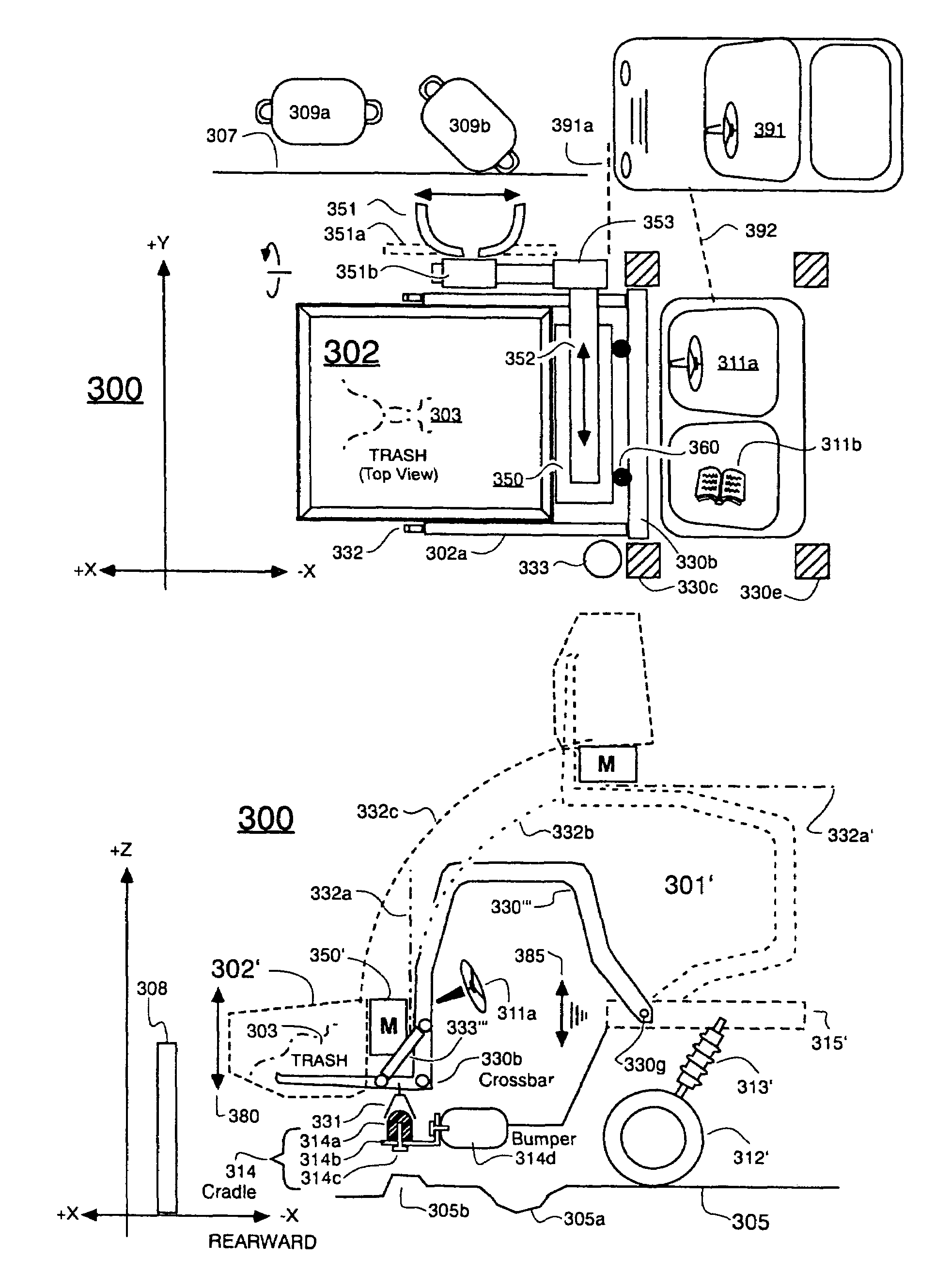Front-loadable refuse container having side-loading robotic arm with motors and other mass mounted at rear of container and use of same with front-loading waste-hauling vehicle having hydraulic front forks or other retractably engageable lift means
a technology of front-loading and waste cans, which is applied in the field of commercial scale collection and hauling of refuse, can solve the problems of manual fetching, hauling, lifting and/or returning of waste cans, affecting the width of containers, and the driver still has to work, so as to reduce the volume of waste and the negative impact on the width-wise volume of containers
- Summary
- Abstract
- Description
- Claims
- Application Information
AI Technical Summary
Benefits of technology
Problems solved by technology
Method used
Image
Examples
embodiment 300
[0074]Other cooperating shapes may be used for the combination of the bumper-engaging coupling 331 and the elastomeric projection 314a besides bell and dome. For example, the bumper bracket 314b could be cup shaped and lined on its interior with elastomeric material while the bumper-engaging coupling 331 could instead be ball-shaped to fit into and ride inside the elastomerically-lined cup. The order of where the elastomeric material resides and where the bumper-engaging coupling resides can be reversed or other wise rearranged. For example, the elastomeric material may instead ride in bell 331 while projection 314a becomes a metal ball to fit ball-in-socket fashion into the elastomerically-lined bell (331). Elastomeric material may be provided both in the portion that rides on the vehicle bumper 314d and the portion of the cradle mechanism which moves with the forks. The end result is that stresses and strains from various shakings of the robotic arm mechanism 350′ can be absorbed ...
embodiment 400
[0097]Each outer pocket member 405 may include an angled portion 405a that aligns with a similarly angled chamfer 407 in the bottom curbside and streetside edges of the container 402″. A similarly angled surface may be provided on each of the reinforcement extension members 402e″ (only one shown) of the container. The angled outer surface 405a of each outer pocket member 405 may be welded, bolted, and / or otherwise fastened to the correspondingly angled walls of the main container and of the re-enforcement extension members 402e″. The inside-located ends of the reinforcement extension members 402e″ (the ends near the crossbar) may also function as bumper pads. Although a fork-based embodiment 400″ has been detailed in FIG. 4B, it is within the contemplation of the disclosure that elastomeric damping means may be integrally incorporated into embodiments which allow for other retractably engageable lift means. For example, if the A-frame approach is implemented, the elastomeric damping...
embodiment 500
[0102]FIGS. 5A–5B respectively show top and side schematic views of another embodiment 500. Where practical like reference numbers in the “500” century series are used for elements of FIGS. 5A–5B that have counterpart elements in the “300” century series in FIGS. 3A–3B. It may be readily seen that there are two robotic arms 351′ and 551 in FIG. 5A. The back-mounted arm may be essentially the same as in the previous figures and may have most or all of its motor mass mounted in rear portion 350′. The front-mounted arm 551 is arranged to pick up waste items (e.g., 509c) disposed on the opposed, left side of the intermediate container at the same time that arm 351′ picks up waste items (e.g., 509b) disposed on the right side. The front-mounted arm mechanism 550 is not a full mirror image of the back-mounted portion 350′. Instead, a substantial portion of the motor mass and controls mass for the front-mounted arm 550 resides in the back-mounted portion 350′. Low-mass, power transferring ...
PUM
| Property | Measurement | Unit |
|---|---|---|
| width | aaaaa | aaaaa |
| width | aaaaa | aaaaa |
| length | aaaaa | aaaaa |
Abstract
Description
Claims
Application Information
 Login to View More
Login to View More - R&D
- Intellectual Property
- Life Sciences
- Materials
- Tech Scout
- Unparalleled Data Quality
- Higher Quality Content
- 60% Fewer Hallucinations
Browse by: Latest US Patents, China's latest patents, Technical Efficacy Thesaurus, Application Domain, Technology Topic, Popular Technical Reports.
© 2025 PatSnap. All rights reserved.Legal|Privacy policy|Modern Slavery Act Transparency Statement|Sitemap|About US| Contact US: help@patsnap.com



